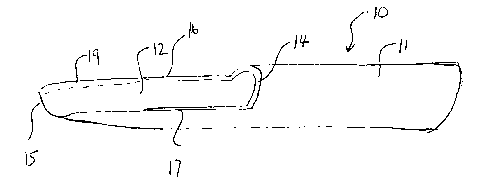Some of the information on this Web page has been provided by external sources. The Government of Canada is not responsible for the accuracy, reliability or currency of the information supplied by external sources. Users wishing to rely upon this information should consult directly with the source of the information. Content provided by external sources is not subject to official languages, privacy and accessibility requirements.
Any discrepancies in the text and image of the Claims and Abstract are due to differing posting times. Text of the Claims and Abstract are posted:
| (12) Patent Application: | (11) CA 2499217 |
|---|---|
| (54) English Title: | SURGICAL TOOL FOR REMOVAL OF BRAIN STEM |
| (54) French Title: | OUTIL CHIRURGICAL POUR L'ENLEVEMENT DU TRONC CEREBRAL |
| Status: | Deemed Abandoned and Beyond the Period of Reinstatement - Pending Response to Notice of Disregarded Communication |
| (51) International Patent Classification (IPC): |
|
|---|---|
| (72) Inventors : |
|
| (73) Owners : |
|
| (71) Applicants : |
|
| (74) Agent: | BATTISON WILLIAMS DUPUIS |
| (74) Associate agent: | |
| (45) Issued: | |
| (22) Filed Date: | 2005-03-03 |
| (41) Open to Public Inspection: | 2006-09-03 |
| Availability of licence: | N/A |
| Dedicated to the Public: | N/A |
| (25) Language of filing: | English |
| Patent Cooperation Treaty (PCT): | No |
|---|
| (30) Application Priority Data: | None |
|---|
A method for extracting at least a sample of the brain stem of an
animal for testing is carried out using a metal tool having a tubular handle
portion of
the metal body and a part tubular operating portion of the metal body defining
a
blade and scoop, inserting the operating portion while holding the handle into
the
cranial cavity of the head of the animal through the foramen magnum, rotating
the
tool to sever the cranial nerves and withdrawing the tool with the brain stem
cradled
in the operating portion.
Note: Claims are shown in the official language in which they were submitted.
Note: Descriptions are shown in the official language in which they were submitted.

2024-08-01:As part of the Next Generation Patents (NGP) transition, the Canadian Patents Database (CPD) now contains a more detailed Event History, which replicates the Event Log of our new back-office solution.
Please note that "Inactive:" events refers to events no longer in use in our new back-office solution.
For a clearer understanding of the status of the application/patent presented on this page, the site Disclaimer , as well as the definitions for Patent , Event History , Maintenance Fee and Payment History should be consulted.
| Description | Date |
|---|---|
| Application Not Reinstated by Deadline | 2011-03-03 |
| Time Limit for Reversal Expired | 2011-03-03 |
| Inactive: Abandon-RFE+Late fee unpaid-Correspondence sent | 2010-03-03 |
| Deemed Abandoned - Failure to Respond to Maintenance Fee Notice | 2010-03-03 |
| Small Entity Declaration Determined Compliant | 2007-09-12 |
| Inactive: Cover page published | 2006-09-03 |
| Application Published (Open to Public Inspection) | 2006-09-03 |
| Inactive: IPC assigned | 2005-04-26 |
| Inactive: First IPC assigned | 2005-04-26 |
| Application Received - Regular National | 2005-04-07 |
| Filing Requirements Determined Compliant | 2005-04-07 |
| Inactive: Filing certificate - No RFE (English) | 2005-04-07 |
| Abandonment Date | Reason | Reinstatement Date |
|---|---|---|
| 2010-03-03 |
The last payment was received on 2009-01-30
Note : If the full payment has not been received on or before the date indicated, a further fee may be required which may be one of the following
Please refer to the CIPO Patent Fees web page to see all current fee amounts.
| Fee Type | Anniversary Year | Due Date | Paid Date |
|---|---|---|---|
| Application fee - small | 2005-03-03 | ||
| MF (application, 2nd anniv.) - small | 02 | 2007-03-05 | 2007-01-22 |
| MF (application, 3rd anniv.) - small | 03 | 2008-03-03 | 2008-02-04 |
| MF (application, 4th anniv.) - small | 04 | 2009-03-03 | 2009-01-30 |
Note: Records showing the ownership history in alphabetical order.
| Current Owners on Record |
|---|
| ADRIEN GRENIER |
| Past Owners on Record |
|---|
| None |